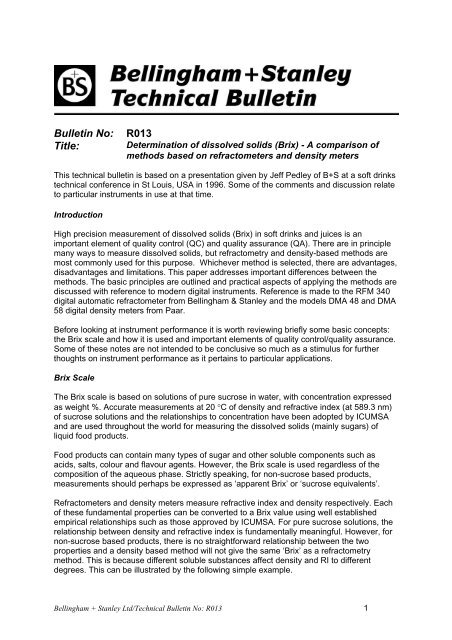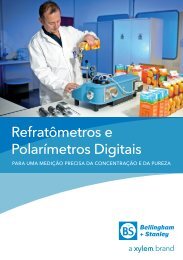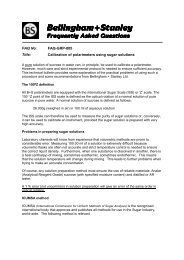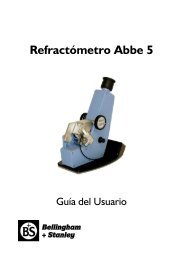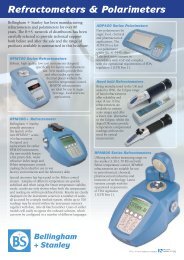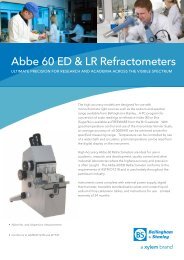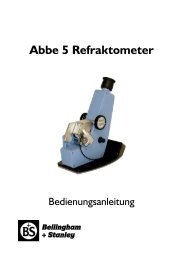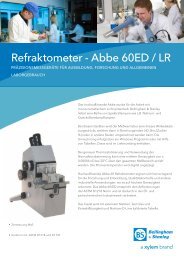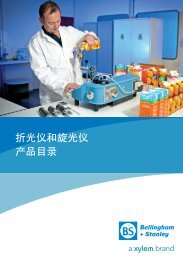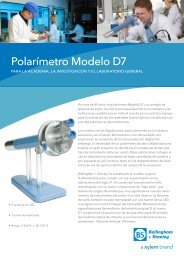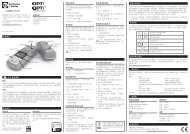Determination Of Dissolved Solids - Bellingham and Stanley
Determination Of Dissolved Solids - Bellingham and Stanley
Determination Of Dissolved Solids - Bellingham and Stanley
Create successful ePaper yourself
Turn your PDF publications into a flip-book with our unique Google optimized e-Paper software.
Bulletin No:Title:R013<strong>Determination</strong> of dissolved solids (Brix) - A comparison ofmethods based on refractometers <strong>and</strong> density metersThis technical bulletin is based on a presentation given by Jeff Pedley of B+S at a soft drinkstechnical conference in St Louis, USA in 1996. Some of the comments <strong>and</strong> discussion relateto particular instruments in use at that time.IntroductionHigh precision measurement of dissolved solids (Brix) in soft drinks <strong>and</strong> juices is animportant element of quality control (QC) <strong>and</strong> quality assurance (QA). There are in principlemany ways to measure dissolved solids, but refractometry <strong>and</strong> density-based methods aremost commonly used for this purpose. Whichever method is selected, there are advantages,disadvantages <strong>and</strong> limitations. This paper addresses important differences between themethods. The basic principles are outlined <strong>and</strong> practical aspects of applying the methods arediscussed with reference to modern digital instruments. Reference is made to the RFM 340digital automatic refractometer from <strong>Bellingham</strong> & <strong>Stanley</strong> <strong>and</strong> the models DMA 48 <strong>and</strong> DMA58 digital density meters from Paar.Before looking at instrument performance it is worth reviewing briefly some basic concepts:the Brix scale <strong>and</strong> how it is used <strong>and</strong> important elements of quality control/quality assurance.Some of these notes are not intended to be conclusive so much as a stimulus for furtherthoughts on instrument performance as it pertains to particular applications.Brix ScaleThe Brix scale is based on solutions of pure sucrose in water, with concentration expressedas weight %. Accurate measurements at 20 °C of density <strong>and</strong> refractive index (at 589.3 nm)of sucrose solutions <strong>and</strong> the relationships to concentration have been adopted by ICUMSA<strong>and</strong> are used throughout the world for measuring the dissolved solids (mainly sugars) ofliquid food products.Food products can contain many types of sugar <strong>and</strong> other soluble components such asacids, salts, colour <strong>and</strong> flavour agents. However, the Brix scale is used regardless of thecomposition of the aqueous phase. Strictly speaking, for non-sucrose based products,measurements should perhaps be expressed as ‘apparent Brix’ or ‘sucrose equivalents’.Refractometers <strong>and</strong> density meters measure refractive index <strong>and</strong> density respectively. Eachof these fundamental properties can be converted to a Brix value using well establishedempirical relationships such as those approved by ICUMSA. For pure sucrose solutions, therelationship between density <strong>and</strong> refractive index is fundamentally meaningful. However, fornon-sucrose based products, there is no straightforward relationship between the twoproperties <strong>and</strong> a density based method will not give the same ‘Brix’ as a refractometrymethod. This is because different soluble substances affect density <strong>and</strong> RI to differentdegrees. This can be illustrated by the following simple example.<strong>Bellingham</strong> + <strong>Stanley</strong> Ltd/Technical Bulletin No: R013 1
Let us assume that we have a hypothetical drink that contains 10.00 % wt of sugar suppliedin the form of high fructose corn syrup (HFCS * ) <strong>and</strong> water with no other components.At 20 °C this liquid will have a refractive index of 1.34762Using the ICUMSA RI/Brix conversion table, a Brix value of 9.87 % is obtained.The same drink will have a density at 20 °C of 1038.38 kg m -3 . Using the ICUMSABrix/density relationship, a Brix value of 10.06 % is obtained - a difference of 0.19%.Which value is correct? Neither, or at least they may both be regarded as ‘equally incorrect’.<strong>Of</strong> course, either value is perfectly acceptable for the purpose of QC/QA, provided themethod <strong>and</strong> target value is clearly specified <strong>and</strong> used consistently. A change of method willclearly necessitate a change in specification. The only exception is for pure sucrosesolutions.Quality Control (QC) <strong>and</strong> Quality Assurance (QA)Reliable Brix measurements are needed during preparative stages such as componentdosing or concentrate dilution operations (QC) <strong>and</strong> final product compliance testing (QA).Incorrect or erratic measurements are often blamed on the instrument. However, there arepotentially a number of sources of error:- sample type - colour, homogeneity, viscosity can affectmeasurements- pulps <strong>and</strong> syrups are generally more problematicthan finished drinks- sample preparation - degassing <strong>and</strong>/or filtration may be important- experimental protocol - instrument cleaning routine, sampling techniques,time delays for sample equilibration must be defined- instrument performance - adequate stability <strong>and</strong> accuracy/precision are limiting<strong>and</strong> last, but certainly not least:- human interaction - care <strong>and</strong> strict adherence to protocol is necessary.The instrument is important but is only one component in the chain. The quality (reliability) ofthe measurement will only be as good as the weakest component in the chain.Repeatability <strong>and</strong> ReproducibilityAccuracy is a term often used in a generic fashion to mean different things. It is wrong to use‘accuracy’ for Brix measurements without some reference to the method or instrument used(NB density vs RI) <strong>and</strong> perhaps the product composition; for example the Brix will change ifthe sugar type/source is changed.The true accuracy of an instrument can be verified using appropriate calibration st<strong>and</strong>ardssuch as pure, freshly prepared, sucrose solutions or oils (RI scale). Having established thatan instrument can measure ‘accurately’, there is a further requirement for repeatability (orprecision) <strong>and</strong> reproducibility; both essential elements of reliable QA <strong>and</strong> QC methods.* HFCS - fructose 90.8%, dextrose 7.7%, maltose 1.2%, trace components 0.3%<strong>Bellingham</strong> + <strong>Stanley</strong> Ltd/Technical Bulletin No: R013 2
Repeatability may be defined as the difference between successive test results for identicaltest material obtained by the same operator with the same apparatus under constantoperating conditions. Reproducibility is the difference between independent results foridentical test material obtained by different operators working in different laboratories but withthe same apparatus. Both definitions are of course subject to a further statistical constraint.A QA method may specify a requirement for an instrument with a repeatability to ±0.03 Brix.However, systematic errors between different laboratories could yield the following results forthe same product:11.58 ±0.03 (lab 1)11.35 ±0.03 (lab 2)In this case repeatability is within specification but reproducibility is not acceptable. Therecould be a number of reasons for this discrepancy:Factors that affect repeatability (r<strong>and</strong>om errors), e.g.- sample stability- instrument stability (working at its limit)- inadequate temperature control- operator careFactors that affect reproducibility (systematic errors), e.g.- experimental protocol- instrument type or make- instrument set-up, e.g. incorrect calibrationThe resolution of an instrument is another aspect to consider. High resolution (e.g. two orthree decimal places in Brix) does not necessarily mean equivalent accuracy <strong>and</strong> saysnothing about repeatability. It simply specifies the form of the display. An erratic display couldmean the instrument is unstable <strong>and</strong> perhaps unworthy of its resolution. It could, of course,mean the sample is unstable <strong>and</strong> the fluctuations are genuine. Conversely, a stable displaycould mean the instrument is insensitive! It is important to distinguish these effects.When deciding on a particular instrument type, it is clearly important to consider all aspectsof the measurement operation. It may be that ease of use is more important than highresolution <strong>and</strong> certain samples may not justify a high resolution/high repeatability instrument.Sampling techniques <strong>and</strong> sample preparation may be the controlling factors in deciding theoverall error in a method. A high resolution instrument may simply prove to be too sensitive.An instrument that is ideal for one type of sample may be totally unsuitable for another.In the light of the concepts <strong>and</strong> principles described above, we can now consider instruments<strong>and</strong> their performance.Refractometers <strong>and</strong> density meters - basic principles<strong>Dissolved</strong> solids affect both density <strong>and</strong> refractive index (RI) of a liquid. Thus when theconcentration of sugar in water is increased, the density <strong>and</strong> RI increase. In this way densityor RI can be used to determine solute concentration in a binary system.Refractometers <strong>and</strong> density meters are designed according to well-characterisedfundamental physical phenomena.<strong>Bellingham</strong> + <strong>Stanley</strong> Ltd/Technical Bulletin No: R013 3
Refractometers measure refractive index of a material; most practical applications are withliquid samples. Most refractometer designs are based on the critical angle concept. A criticalangle condition is established where an incident beam of known wavelength is totallyinternally reflected from a prism/sample interface. From the geometry of the optical path <strong>and</strong>the known RI of the prism material, the RI of the sample is determined. Modern automaticdigital refractometers such as the RFM 340 from <strong>Bellingham</strong> & <strong>Stanley</strong>, utilise a photodiodearray detection system to determine with high precision the position of the borderlinebetween refracted <strong>and</strong> internally reflected light. A great advantage of this design is that thereare no moving parts that can be subject to mechanical wear. Early digital refractometerswere based on ‘motorised’ designs.Modern digital density meters such as the DMA series from Paar, utilise the effect of densityon the natural resonant frequency of an oscillating U-tube filled with the liquid under test. Asimple equation relates the resonant frequency to the mass, volume <strong>and</strong> density of the testliquid.Modern digital refractometers <strong>and</strong> density meters are equipped with software that performsthe necessary conversion of the measured quantity to a value on a related scale such asBrix. Many other scales can be programmed, for example glucose, fructose, invert sugar,sodium chloride <strong>and</strong> many more. There is no limit to the types of data processing possibleother than by the memory limitations of the instrument. An alternative that is becoming ofincreasing interest is to transmit the data via an RS 232 interface to a PC or LIMS system.RI <strong>and</strong> density change with temperature <strong>and</strong> so good temperature control is an importantrequirement for high precision measurements with both density meters <strong>and</strong> refractometers.However, temperature control is more critical in the case of density measurement. The figurebelow shows an example for 10% sucrose. Achieving adequate thermal equilibrium in themeasuring chamber can make density measurements rather slow.Automatic temperature compensation (TC) is available as a feature on most instruments,although this is generally based on Brix (sucrose data). For non-sucrose, sugar-basedproducts the TC will still be a good approximation, although errors are then likely to begreater with density measurements because of the higher temperature coefficients.Many laboratories prefer to use TC rather than employ temperature control. However, highresolution refractometers such as the RFM 340 (resolution to 0.01 Brix) perform better withapplied temperature control - thermostat/circulator. This is because the stable heat sinkprovided by the water serves not only to control the temperature of the prism plate assembly,but also to stabilise the internal environment of the instrument against external temperaturefluctuations (heat transfer from surroundings or hot/cold samples). This enhanced stabilityenables the instrument to hold its calibration more reliably <strong>and</strong> reduces the need for frequentzeroing of the instrument.Density meters such as the DMA 48 <strong>and</strong> 58 models have the advantage of built-in highprecision temperature control. The higher resolution DMA 58 is proportionally moredependent on good temperature control <strong>and</strong> this does reflect somewhat in the significantlyhigher cost of this instrument.<strong>Bellingham</strong> + <strong>Stanley</strong> Ltd/Technical Bulletin No: R013 4
Effect of Temperature on Refractive Index <strong>and</strong>Density of 10% Sucrose Solution(Relative to values at 20 deg C)% change relative to 20 degC0.5000.0000 20 40 60 80 100-0.500-1.000-1.500-2.000-2.500-3.000-3.500-4.000Temperature (deg C)density rel to 20 CRI rel to 20 CComparison of a digital refractometer with a digital density meterWhat should we look for in a good instrument?- repeatability (precision)- reproducibility- simple operation- speed- easy cleaning- simple calibration- friendly software- set-up security- durability- minimal maintenance- flexible data h<strong>and</strong>ling/recording- flexibility (multi-mode)- possibly, size - small footprint?- good supplier supportAnd, of course, all at a low price!Another factor perhaps is familiarity. Companies have a tendency to invest in a particulartechnique <strong>and</strong> are then naturally reluctant to change. Uniformity of instrumentationthroughout an organisation may be important, particularly if inter-laboratory cross referencingof product quality is required. Digital density meters appeared on the market in the seventiesbefore digital refractometers. A number of companies therefore opted for densitymeasurement because of this advance in technology.<strong>Bellingham</strong> + <strong>Stanley</strong> Ltd/Technical Bulletin No: R013 5
A choice between refractometry <strong>and</strong> densimetry is not simply a case of selecting the highestpossible resolution/repeatability; other factors must be considered. The following table liststhe important differences (<strong>and</strong> similarities) between an RFM 340 refractometer <strong>and</strong> DMA48/58 density meters.Feature Refractometer Density MeterSample type Any ‘fluid’ Limited by viscosity <strong>and</strong>homogeneitySample applicationDirect to prism or flowthroughFlow throughMeasurement time 6-30 seconds 0.5 - 8 minutesSample degassing Can be important EssentialTemperature equilibration 6-30 seconds 0.5 - 3.5 minutesCalibration time 1-2 minutes 10 minutesResolution0.00001 RI0.01 Brix0.0001 g cm -3 (DMA 48)0.00001 g cm -3 (DMA 58)Repeatability (Brix)Samples 0-20 %BrixRepeatability (Brix)Syrups± 0.02 ± 0.01 (DMA 58)± 0.025 (DMA 48)±0.03 to 0.1 ± 0.1 (DMA 48)Cleaning Easy wash/wipe Difficult, 10-20 ml sample flushWeight 6.2 kg 25 kgServicing/maintenanceNo moving partsInstrument validation onlyMechanical wear possibleAnnual check recommendedPower 12 v remote Mains 220/110 vFifteen to twenty years of practical experience with digital instruments has shown that, whenused correctly, both refractometers <strong>and</strong> density meters will provide reliable measurementsfor QC/QA in the drinks industry. Instruments of both type are capable of the same sort ofresolution/precision (repeatability) - for practical purposes, approximately ±0.01 to 0.03 Brix,depending upon sample type <strong>and</strong> measuring range. A density meter working on ‘wellbehaved samples’ will repeat to perhaps ±0.005 Brix, but this cannot be regarded as ageneral specification. Similarly, a differential refractometer (different working principle to anRFM 340) working in a narrow Brix range on some products could perhaps achieve arepeatability better than ±0.01 Brix.Refractometers are more tolerant to sample type. Degassing may be important forcarbonated drinks if bubbles have a tendency to accumulate on the prism surface but for<strong>Bellingham</strong> + <strong>Stanley</strong> Ltd/Technical Bulletin No: R013 6
density meters the absence of bubbles is essential. Inhomogeneous samples such as juicescontaining residual particles cannot be measured reliably with density meters. The samesamples can be measured on a refractometer but repeatability may be dependent on areliable sampling <strong>and</strong> measurement protocol. The RFM 340 has a special feature whichgives the user a numerical measure of sample quality (a measure of the difficulty indiscerning the critical angle borderline). This parameter can be a useful tool for testing‘difficult’ samples.Effective cleaning between measurements is essential for both methods to ensure maximumperformance. Refractometers such as the RFM 340 with a readily accessible prism surfaceare easier to clean than flow through cells/density tubes. This is particularly so with viscousfluids that might require excessive flushing with clean water or solvent. Also, drying out of asugar solution can leave behind films/deposits that cause large errors on re-solution.Cleaning can be a time consuming operation.The DMA density meters have the attractive feature of built-in heating <strong>and</strong> temperaturecontrol but thermal equilibration can be slow because of high dependence of density ontemperature. Water circulation, although regarded as a clumsy method for temperaturecontrol, does provide a refractometer with a large heat sink that quickly absorbs heattransferred from the relatively small sample volume <strong>and</strong> maintains the instrument in a stablecondition, thereby minimising ‘calibration drift’.Syrups are not so easily measured with either instrument type. Near saturationconcentrations of sugar affect ‘water structure’ <strong>and</strong> hence RI/density. High concentrationsyrups are therefore often inherently unstable <strong>and</strong> Brix repeatability is relatively poor.Refractometers are nevertheless easier to use with syrups; the high viscosity makessampling <strong>and</strong> cleaning very slow with density meters.Partially inverted sugar is a problem <strong>and</strong> cannot be quantified by either refractometer ordensity meter alone. Sucrose is a chemically unstable disaccharide which hydrolyses to forma molecule of glucose <strong>and</strong> a molecule of fructose. In doing so, a molecule of water isabsorbed thereby increasing both the density <strong>and</strong> refractive index of the solution.C 12 H 22 O 11 + H 2 0 → C 6 H 12 O 6 + C 6 H 12 O 6Sucrose Glucose FructoseThe reaction is catalysed by acid <strong>and</strong> so sucrose-based drinks containing, for example,phosphoric or citric acids will undergo spontaneous inversion. If a drink is partially invertedduring QA testing the ‘apparent Brix’ value obtained with either a density meter orrefractometer will be unreliable, being dependant upon sample history (ambient temperature,time of st<strong>and</strong>ing, pH etc). To obtain an unambiguous result, ‘partial inverts’ can be dealt within one of two ways: either by forcing complete inversion (heat, added acid) <strong>and</strong> measuring100% invert sugar or by using a separate technique such as polarimetry to complement therefractometer/density measurement.Putting aside preference based on ‘familiarity’, <strong>and</strong> given the types of instruments currentlyavailable, choice will probably become a compromise between desired precision <strong>and</strong> theconsequent constraints <strong>and</strong> cost this imposes on the overall measurement procedure. Timeconsumption <strong>and</strong> ease of use can be paramount <strong>and</strong> it is important to match the instrumentcapability with a realistic expectation of what can actually be achieved with a particularproduct <strong>and</strong> process line. And, of course, instrument price should equate with the expectedcost savings through improved operating efficiency <strong>and</strong>/or tighter process control.For the majority of applications, the important differences between density meters <strong>and</strong>refractometers centre primarily around ease of use <strong>and</strong> speed of measurement. Higher<strong>Bellingham</strong> + <strong>Stanley</strong> Ltd/Technical Bulletin No: R013 7
precision density meters may give marginal improvements in resolution <strong>and</strong> repeatability forcertain ‘well behaved’ samples, but at a considerably higher price.Some thoughts for future developmentThere was a time when manufacturers dictated instrument designs based on their perceivedunderst<strong>and</strong>ing of industrial requirements. In turn, presumably, industries developed qualitytests based around the capability of available instrumentation. This is no longer the case.Nowadays, the customer dem<strong>and</strong>s the specification <strong>and</strong> hopefully the instrumentmanufacturer complies. In future, instrument manufacturers will have to be prepared for agreater degree of flexibility <strong>and</strong> customer orientation.Improvements in software <strong>and</strong> instrument communication interfaces in the last two decadeshave enabled many possibilities for data manipulation <strong>and</strong> recording <strong>and</strong> the scope isendless. This aspect of instrumentation will inevitably develop rapidly as companies perfecttheir quality management systems <strong>and</strong> inflict greater dem<strong>and</strong>s on the ‘data management’capabilities of instruments <strong>and</strong> associated computer systems. Vast amounts of productinformation storage, data correlation <strong>and</strong> statistical analysis will be possible thus enabling agreater degree of automated quality control.Hardware changes are a different matter. The current generation of automatic digitalrefractometers such as the RFM340 have been designed for ‘benchtop’ applications withmultiple use ranging from drinks to fruit pulps, sauces, jams, syrups, not to mention the manyapplications outside the food industry, in particular chemical, oil <strong>and</strong> pharmaceuticalindustries. If higher <strong>and</strong> higher measurement precision is a realistic scenario, given thevaried nature of the c<strong>and</strong>idate products <strong>and</strong> processes, then a change from this ‘st<strong>and</strong>ard’instrument type is likely.It may be possible to improve measurement of Brix by, say, an order of magnitude inprecision for a finished drink, but a different instrument, operating on a different measuringrange would then have to be prescribed for a concentrate or syrup. It may be necessary todesign instruments specifically for one customer <strong>and</strong> maybe just one product, assuming thisis a cost effective solution for both manufacturer <strong>and</strong> customer.The other likely trend will be towards greater process control, thereby relying more <strong>and</strong> moreupon in-line monitoring rather than the slower process of turn around of data from the qualitylaboratory. There is considerable scope for co-operation between the drink producer <strong>and</strong> theinstrument manufacturer in this respect to design the ideal measuring system with automaticdata capture to an integrated process control information system. Such systems are alreadyin use but more widespread progression towards this approach seems inevitable.One thing is for sure, instrument manufacturers will have to work more closely withcustomers than ever before.<strong>Bellingham</strong> + <strong>Stanley</strong> Ltd/Technical Bulletin No: R013 8


